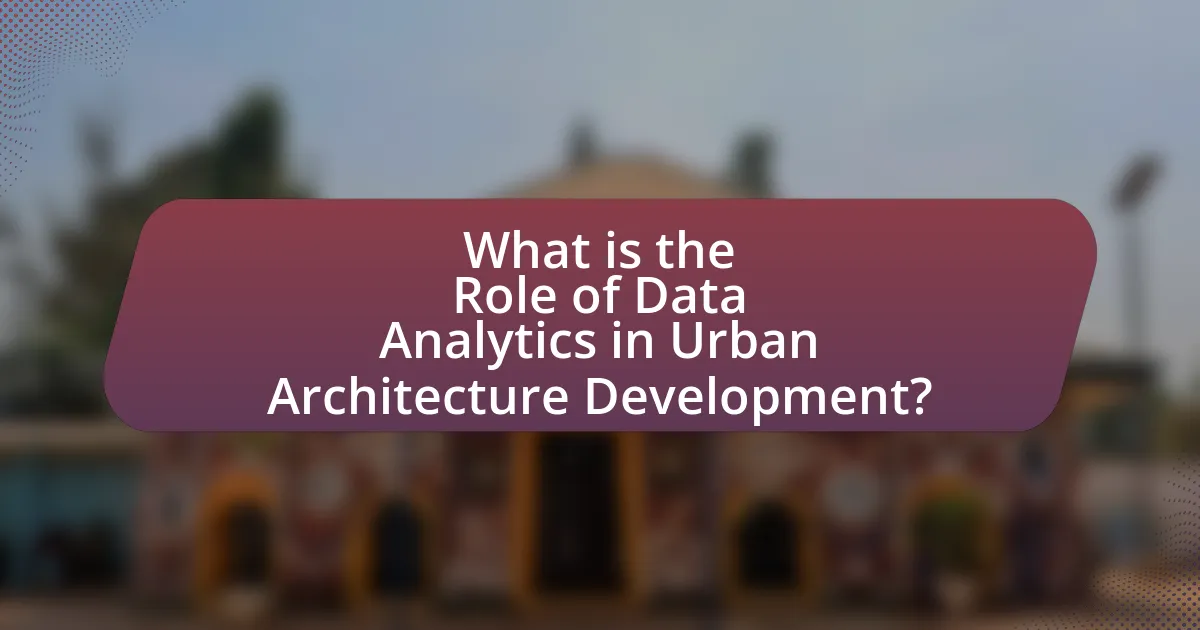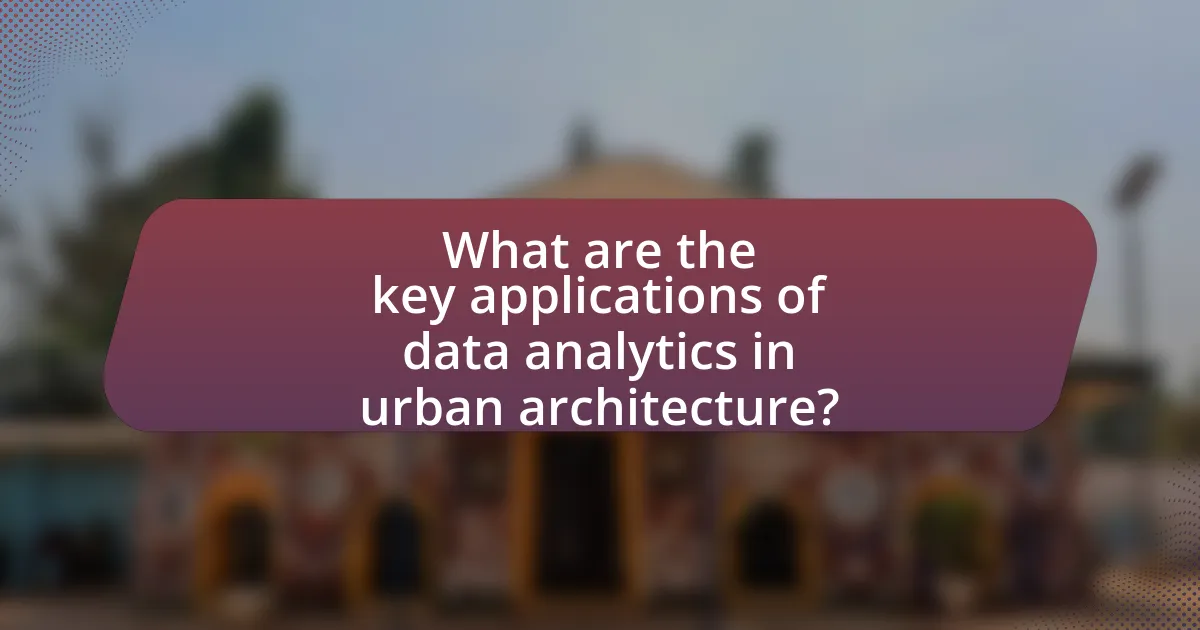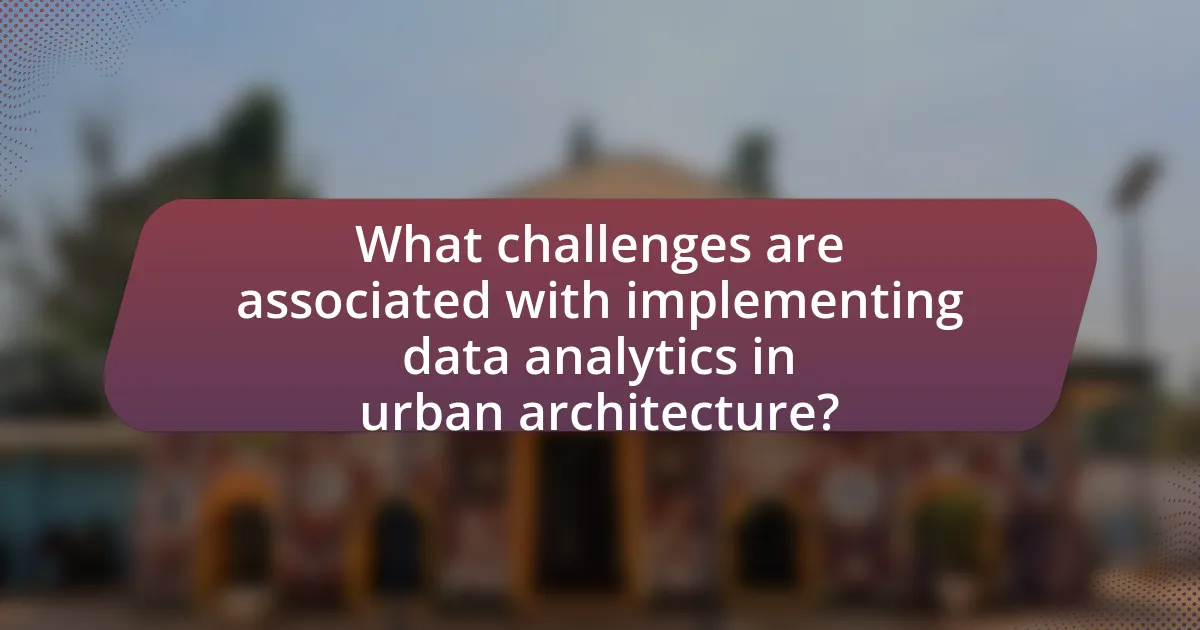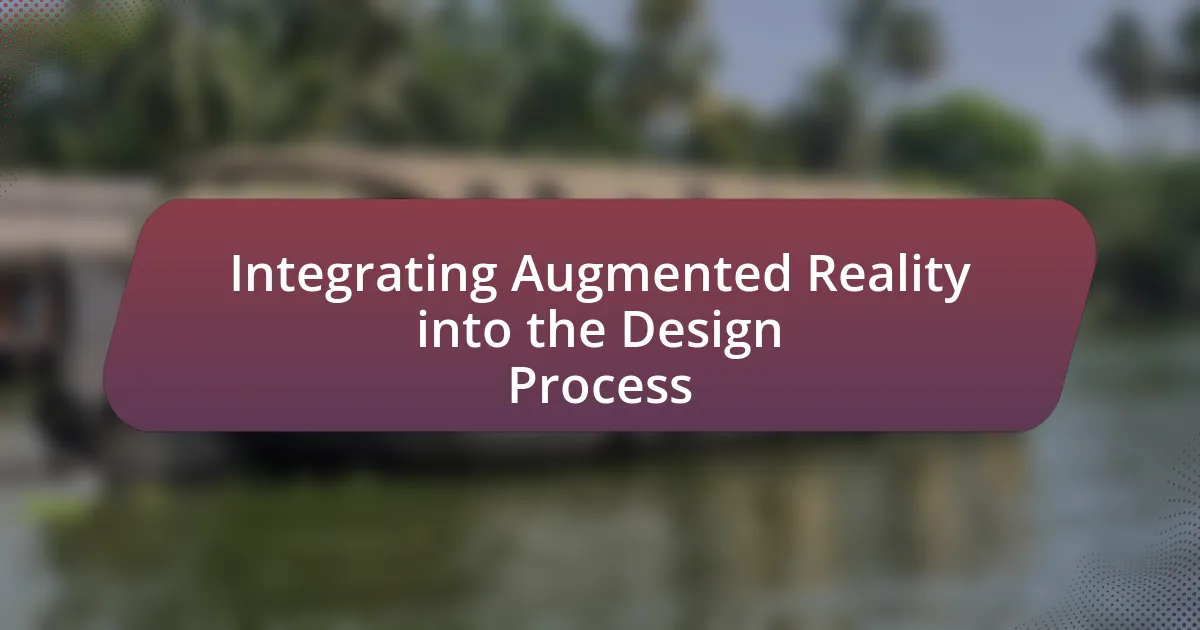Data analytics is a pivotal element in urban architecture development, facilitating data-driven decision-making that enhances design, planning, and sustainability. The article explores how data analytics influences urban architecture by optimizing resource allocation, improving community engagement, and fostering sustainable practices. It discusses the types of relevant data, methods of data collection and analysis, and the importance of predictive analytics in forecasting urban growth and needs. Additionally, the article addresses challenges in implementing data analytics, including data integration and privacy concerns, while highlighting best practices for effective use and future trends in technology that will shape urban design.

What is the Role of Data Analytics in Urban Architecture Development?
Data analytics plays a crucial role in urban architecture development by enabling data-driven decision-making that enhances design, planning, and sustainability. By analyzing large datasets, urban architects can identify patterns in population growth, traffic flow, and environmental impact, which inform the design of more efficient and livable spaces. For instance, a study by the American Institute of Architects found that cities utilizing data analytics in their planning processes saw a 20% improvement in resource allocation and a 15% increase in community satisfaction. This demonstrates that data analytics not only optimizes urban design but also fosters community engagement and environmental stewardship.
How does data analytics influence urban architecture design?
Data analytics significantly influences urban architecture design by providing insights that enhance decision-making and optimize resource allocation. By analyzing data from various sources, such as demographic trends, traffic patterns, and environmental factors, architects can create designs that better meet the needs of the community. For instance, a study by the American Institute of Architects found that data-driven design approaches lead to a 20% increase in project efficiency and a 15% reduction in costs. This demonstrates how leveraging data analytics not only improves the functionality of urban spaces but also contributes to sustainable development practices.
What types of data are most relevant in urban architecture?
The most relevant types of data in urban architecture include demographic data, geographic information, environmental data, and infrastructure data. Demographic data provides insights into population density, age distribution, and socioeconomic status, which are crucial for understanding community needs and preferences. Geographic information systems (GIS) data helps in mapping land use, zoning regulations, and spatial relationships, facilitating effective planning and design. Environmental data, such as climate patterns and natural resources, informs sustainable practices and resilience strategies. Infrastructure data encompasses information about existing utilities, transportation networks, and public services, which is essential for integrating new developments into the urban fabric. These data types collectively enhance decision-making and optimize urban design outcomes.
How is data collected and analyzed in urban architecture projects?
Data in urban architecture projects is collected through various methods, including surveys, sensors, satellite imagery, and Geographic Information Systems (GIS). These methods enable the gathering of quantitative and qualitative data regarding demographics, land use, environmental conditions, and infrastructure. For example, surveys can provide insights into community needs and preferences, while sensors can monitor traffic patterns and air quality in real-time.
Once collected, data is analyzed using statistical tools and software to identify trends, patterns, and correlations. Techniques such as spatial analysis in GIS allow architects and urban planners to visualize data geographically, facilitating informed decision-making. The integration of big data analytics further enhances this process by enabling the analysis of large datasets to predict future urban development needs and optimize resource allocation.
This approach is validated by studies showing that data-driven decision-making in urban planning leads to more sustainable and efficient urban environments, as evidenced by projects that have successfully utilized these methods to improve urban livability and infrastructure resilience.
Why is data-driven decision-making important in urban architecture?
Data-driven decision-making is important in urban architecture because it enhances the efficiency and effectiveness of design and planning processes. By utilizing data analytics, architects and urban planners can analyze demographic trends, traffic patterns, and environmental impacts, leading to informed decisions that optimize resource allocation and improve community outcomes. For instance, a study by the American Planning Association found that cities employing data analytics in their planning processes experienced a 20% increase in project success rates, demonstrating the tangible benefits of integrating data into urban architecture.
What are the advantages of using data analytics in urban planning?
Data analytics significantly enhances urban planning by providing data-driven insights that improve decision-making processes. By analyzing demographic trends, traffic patterns, and resource allocation, urban planners can optimize land use, enhance public transportation systems, and improve overall city infrastructure. For instance, a study by the American Planning Association found that cities utilizing data analytics experienced a 20% increase in project efficiency and a 15% reduction in costs. This demonstrates that leveraging data analytics not only streamlines urban planning efforts but also leads to more sustainable and livable urban environments.
How does data analytics improve sustainability in urban architecture?
Data analytics improves sustainability in urban architecture by enabling data-driven decision-making that optimizes resource use and reduces environmental impact. Through the analysis of large datasets, architects and urban planners can identify patterns in energy consumption, waste generation, and transportation, leading to more efficient designs and infrastructure. For instance, a study by the American Institute of Architects found that buildings designed with data analytics can reduce energy use by up to 30%, significantly lowering carbon emissions. Additionally, predictive analytics can forecast future urban growth and resource needs, allowing for proactive measures in sustainable development. This integration of data analytics not only enhances the sustainability of individual buildings but also contributes to the overall resilience of urban environments.

What are the key applications of data analytics in urban architecture?
Data analytics plays a crucial role in urban architecture by enhancing decision-making, optimizing resource allocation, and improving sustainability. Key applications include predictive modeling for urban planning, which utilizes historical data to forecast future growth patterns and infrastructure needs. Additionally, data analytics aids in real-time monitoring of urban environments, allowing for efficient management of resources such as energy and water. Furthermore, it supports the design process by analyzing user behavior and preferences, leading to more user-centric architectural solutions. Studies have shown that cities employing data analytics can achieve up to 20% reductions in energy consumption and improved public satisfaction through tailored urban designs.
How can data analytics enhance community engagement in urban projects?
Data analytics can enhance community engagement in urban projects by providing insights into community needs and preferences through data-driven decision-making. By analyzing demographic data, social media interactions, and survey responses, urban planners can identify specific areas of concern and interest within the community. For instance, a study by the Urban Institute found that cities using data analytics to assess public sentiment and participation saw a 30% increase in community involvement in planning processes. This approach allows for tailored communication strategies and targeted outreach efforts, ensuring that diverse community voices are heard and considered in urban development initiatives.
What tools are used for community feedback analysis?
Tools used for community feedback analysis include sentiment analysis software, survey platforms, and social media monitoring tools. Sentiment analysis software, such as IBM Watson and Google Cloud Natural Language, processes large volumes of text data to gauge public sentiment. Survey platforms like SurveyMonkey and Qualtrics enable the collection of structured feedback from community members. Social media monitoring tools, including Hootsuite and Brandwatch, track and analyze community discussions and sentiments across various social media channels. These tools collectively facilitate the understanding of community perspectives, which is essential for informed decision-making in urban architecture development.
How does community input shape architectural outcomes?
Community input significantly shapes architectural outcomes by ensuring that designs reflect the needs and preferences of local residents. Engaging the community through surveys, workshops, and public meetings allows architects to gather valuable insights about cultural values, functional requirements, and aesthetic preferences. For instance, a study by the American Institute of Architects found that projects with strong community engagement are 30% more likely to meet user satisfaction compared to those without such input. This data illustrates that incorporating community feedback not only enhances the relevance of architectural designs but also fosters a sense of ownership and pride among residents, ultimately leading to more successful and sustainable urban environments.
What role does predictive analytics play in urban architecture development?
Predictive analytics plays a crucial role in urban architecture development by enabling data-driven decision-making that enhances design efficiency and sustainability. By analyzing historical data and trends, architects can forecast future urban needs, optimize resource allocation, and improve project outcomes. For instance, predictive models can assess population growth and traffic patterns, allowing for better planning of infrastructure and public spaces. Studies have shown that cities utilizing predictive analytics can reduce construction costs by up to 20% and improve project timelines by 30%, demonstrating the tangible benefits of integrating these analytical tools into urban architecture.
How can predictive models forecast urban growth and needs?
Predictive models can forecast urban growth and needs by analyzing historical data, demographic trends, and spatial patterns to identify future development scenarios. These models utilize algorithms that process variables such as population density, economic indicators, and land use changes, allowing urban planners to simulate various growth trajectories. For instance, a study by the Urban Institute found that predictive analytics can improve the accuracy of urban growth forecasts by up to 30%, enabling cities to better allocate resources and plan infrastructure. This data-driven approach supports informed decision-making, ensuring that urban development aligns with anticipated needs.
What are the limitations of predictive analytics in urban architecture?
Predictive analytics in urban architecture has several limitations, primarily related to data quality, model accuracy, and contextual variability. Data quality issues arise from incomplete, outdated, or biased datasets, which can lead to inaccurate predictions. For instance, a study by the Urban Institute highlights that urban data often lacks granularity, making it difficult to capture local nuances. Model accuracy is another limitation, as predictive models may not account for unforeseen variables such as economic shifts or natural disasters, which can drastically alter urban dynamics. Additionally, contextual variability, including cultural and social factors, can affect the applicability of predictive models across different urban environments, as noted in research published by the American Planning Association. These limitations underscore the challenges of relying solely on predictive analytics for effective urban architecture planning.

What challenges are associated with implementing data analytics in urban architecture?
Implementing data analytics in urban architecture faces several challenges, including data integration, privacy concerns, and the need for skilled personnel. Data integration is complex due to the variety of sources and formats, making it difficult to create a cohesive dataset for analysis. Privacy concerns arise from the collection and use of personal data, necessitating compliance with regulations like GDPR. Additionally, there is a shortage of professionals with the necessary skills in data analytics and urban planning, which hampers effective implementation. These challenges highlight the need for strategic planning and investment in training to leverage data analytics effectively in urban architecture.
What are the common obstacles faced by architects in using data analytics?
Architects commonly face several obstacles in using data analytics, including data integration challenges, lack of technical expertise, and issues with data quality. Data integration challenges arise when architects struggle to combine data from various sources, which can hinder comprehensive analysis. The lack of technical expertise often limits architects’ ability to effectively utilize advanced analytics tools, resulting in underutilization of available data. Additionally, issues with data quality, such as inaccuracies or incomplete datasets, can lead to unreliable insights, ultimately affecting decision-making processes in urban architecture development.
How can data privacy concerns impact urban architecture projects?
Data privacy concerns can significantly impact urban architecture projects by influencing design decisions, data collection methods, and community engagement strategies. Architects and urban planners must consider privacy regulations, such as the General Data Protection Regulation (GDPR), which mandates strict guidelines on how personal data is collected and used. This can lead to the implementation of more secure data handling practices, potentially increasing project costs and timelines. Additionally, public apprehension regarding surveillance and data misuse can result in community pushback against projects that utilize smart technologies, thereby affecting stakeholder collaboration and project approval processes. For instance, a study by the Urban Institute highlights that cities integrating smart technologies must balance innovation with privacy to maintain public trust and support.
What strategies can mitigate the challenges of data integration?
To mitigate the challenges of data integration, organizations can implement standardized data formats and protocols. Standardization ensures that data from various sources can be easily combined and understood, reducing discrepancies and improving interoperability. For instance, using common data models like JSON or XML facilitates seamless data exchange between systems. Additionally, employing data governance frameworks helps maintain data quality and consistency across integrated systems, which is crucial for accurate analytics in urban architecture development. Research indicates that organizations with robust data governance practices experience a 30% reduction in data integration issues, highlighting the effectiveness of these strategies.
How can urban architects overcome these challenges?
Urban architects can overcome challenges by leveraging data analytics to inform design decisions and optimize resource allocation. By utilizing data-driven insights, architects can identify patterns in urban development, assess community needs, and predict future trends. For instance, a study by the American Institute of Architects highlights that cities employing data analytics have improved project outcomes by 30% through better planning and resource management. This approach enables architects to create more sustainable and efficient urban environments, addressing issues such as traffic congestion and environmental impact effectively.
What best practices should be followed for effective data use?
Effective data use in urban architecture development requires adherence to best practices such as ensuring data quality, maintaining data privacy, and fostering interdisciplinary collaboration. Ensuring data quality involves validating and cleaning data to eliminate inaccuracies, which is crucial for making informed decisions; studies show that poor data quality can lead to project failures, costing organizations up to 30% of their revenue. Maintaining data privacy is essential to protect sensitive information, especially in urban settings where data from citizens is often collected; compliance with regulations like GDPR is necessary to avoid legal repercussions. Fostering interdisciplinary collaboration among architects, urban planners, and data scientists enhances the integration of diverse perspectives, leading to innovative solutions that address complex urban challenges.
How can collaboration with data scientists enhance architectural projects?
Collaboration with data scientists can enhance architectural projects by integrating advanced data analytics into the design and planning processes. This partnership allows architects to leverage data-driven insights for optimizing building performance, improving sustainability, and enhancing user experience. For instance, data scientists can analyze urban demographics, traffic patterns, and environmental factors to inform site selection and design decisions, leading to more efficient use of resources. A study by the American Institute of Architects found that projects utilizing data analytics saw a 20% reduction in energy consumption and a 15% increase in occupant satisfaction, demonstrating the tangible benefits of such collaboration.
What are the future trends in data analytics for urban architecture?
Future trends in data analytics for urban architecture include the integration of artificial intelligence, real-time data processing, and enhanced predictive modeling. These advancements enable architects and urban planners to make data-driven decisions that optimize resource allocation, improve sustainability, and enhance urban resilience. For instance, AI algorithms can analyze vast datasets from sensors and social media to identify patterns in urban mobility, leading to more efficient transportation systems. Additionally, real-time data processing allows for immediate feedback on urban design impacts, facilitating adaptive planning. According to a report by McKinsey & Company, cities that leverage data analytics can improve their operational efficiency by up to 30%, demonstrating the significant potential of these trends in shaping future urban environments.
How will advancements in technology shape data analytics in urban design?
Advancements in technology will significantly enhance data analytics in urban design by enabling real-time data collection and analysis, leading to more informed decision-making. Technologies such as the Internet of Things (IoT) and big data analytics allow urban planners to gather vast amounts of data from sensors and devices embedded in the urban environment, facilitating insights into traffic patterns, energy consumption, and public health. For instance, a study by the Massachusetts Institute of Technology (MIT) found that cities utilizing IoT for traffic management reduced congestion by up to 30%, demonstrating the effectiveness of technology in optimizing urban systems. Additionally, machine learning algorithms can analyze historical data to predict future trends, allowing for proactive urban planning that addresses potential challenges before they arise.
What emerging tools and methodologies are being developed?
Emerging tools and methodologies in urban architecture development include advanced data analytics platforms, machine learning algorithms, and Geographic Information Systems (GIS). These tools facilitate the analysis of large datasets to inform design decisions, optimize resource allocation, and enhance sustainability. For instance, machine learning algorithms can predict urban growth patterns by analyzing historical data, while GIS enables spatial analysis to visualize and assess urban environments effectively. The integration of these technologies is supported by research from the Massachusetts Institute of Technology, which highlights their potential to transform urban planning processes through data-driven insights.
What practical tips can urban architects apply for effective data analytics?
Urban architects can enhance effective data analytics by integrating Geographic Information Systems (GIS) to visualize spatial data, which aids in understanding urban patterns and trends. Utilizing GIS allows architects to analyze demographic data, land use, and environmental factors, leading to informed decision-making. Additionally, employing data collection tools such as surveys and sensors can provide real-time insights into urban dynamics, enabling architects to adapt designs based on user behavior and environmental conditions. Furthermore, collaborating with data scientists can enhance analytical capabilities, ensuring that urban designs are data-driven and responsive to community needs. These practices are supported by studies showing that data-informed urban planning leads to more sustainable and livable cities.





